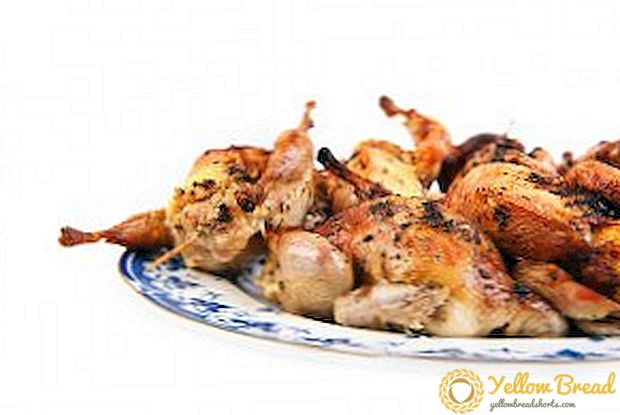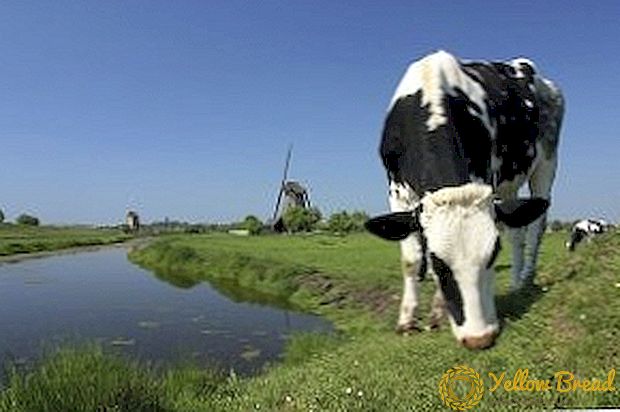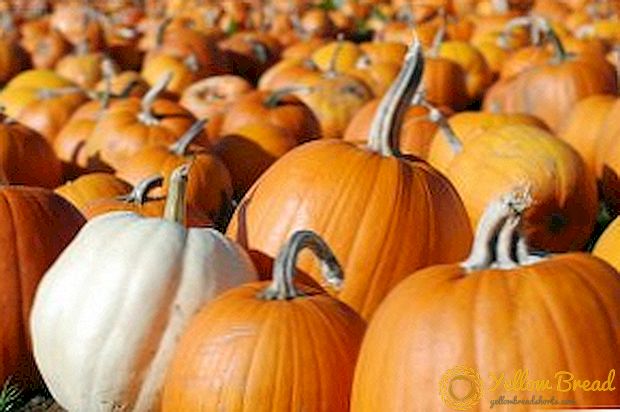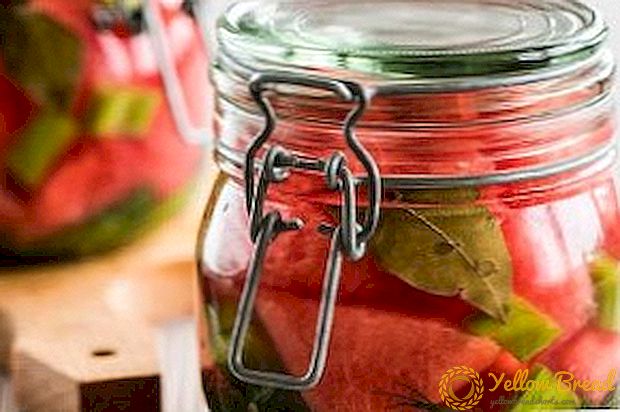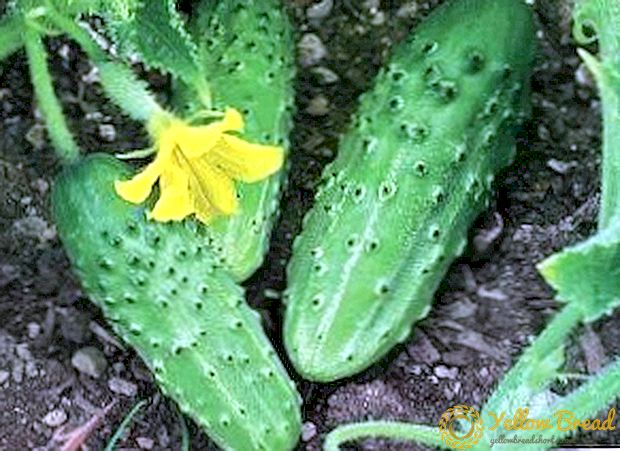 Tomatoes are regular guests on our table in the summer season, and Eagle Heart is a worthy representative of this family.
Tomatoes are regular guests on our table in the summer season, and Eagle Heart is a worthy representative of this family.
Due to its thick pulp, this sort of tomato is used in soups, summer salads, children's purees and for the preparation of tomato paste. In this article we will discuss what this tomato is so good about, the characteristics of its planting and cultivation.
- Description and distinctive features of the variety
- Advantages and disadvantages
- pros
- Minuses
- Self-growing seedlings
- Planting dates
- Capacity and soil
- Seed preparation
- Sowing seeds: the pattern and depth
- Sprouting conditions
- Care of seedlings
- Planting seedlings on a permanent place
- Terms of transplantation
- Optimal scheme
- Features of care and cultivation agrotechnics
- Watering, weeding and loosening
- Forming a bush
- Garter
- Feedings
Description and distinctive features of the variety
"Eagle heart" refers to rose-fruit varieties, known for their sugary pulp and high content of amino acids. For a clearer description of it, it should be noted that the shape of the fetus is similar to “Bull's heart”, but less prone to disease. This tomato was bred for growing in greenhouses, but over time, its popularity has led to the fact that it is now successfully fruiting in the open field.For a more detailed description of the variety let's talk about its pros and cons.
Advantages and disadvantages
The Eagle Heart was quickly liked by both farmers and ordinary gardeners. This was facilitated by a number of its positive characteristics. 
pros
The advantages of this variety include:
- Tasty meaty heart-shaped fruit of large size. Its color varies in shades of red-pink palette, and the average weight - 175-400 g.
- Resistance to adverse weather conditions, various diseases and fungi.
- High yield (8.8-13.6 kg / sq. M.), Subject to favorable soil.
- Dense skin, which rarely cracks, protects the fetus from external damage and allows you to store it for a long time.
Minuses
However, not everything is as rosy as it seems at first glance. This variety has its own pitfalls.
- Requirements for the composition of the soil and its nutritional value.
- It needs a pinching and a garter because of a powerful bush.
Thus, we can conclude that this variety of tomatoes is suitable for growing, rather, experienced gardeners, because it requires attention and care skills. 
Self-growing seedlings
This rather time-consuming process requires attentiveness and the right approach, otherwise there is a risk of destroying all ventures in the bud. For a successful result, you must comply with the necessary conditions.
Planting dates
Starting to grow seedlings is in March or early April, depending on weather conditions.
Capacity and soil
For the "Eagle Heart" fit light soils, based on peat or humus, diluted with garden soil. Also, to increase the nutritional value, wood ash, potash or phosphate fertilizers can be added to the composition. This mixture is filled with special pots, where the landing will be made. Low drawers up to 5-6 cm in depth are ideal.
Seed preparation
Before preparing for sowing, the material should be checked for quality. To do this, immerse the seeds in a glass with 5% salt solution, and those that settle, suitable for planting. It is recommended to soak the seeds in freshly squeezed aloe juice or any other growth stimulator for 12 hours before planting. In the future, it also does not hurt to resort to such seedlings at least once. 
Sowing seeds: the pattern and depth
Seeds are lowered to a depth of 1 cm, and between future shoots should be at least 2-3 cm, so that the grown plant has enough nutrients and there is room for the root system.
Sprouting conditions
At this stage, the future tomato is very fragile, the room temperature is important for it (not less than 25 degrees), so it will not hurt to immediately cover the containers with a film before sowing the first shoots after sowing.For growing seedlings should provide a well-ventilated room, where a lot of sunlight gets.
Care of seedlings
The seeds begin to germinate on the 4-5th day.
After the appearance of sprouts the temperature can be lowered to 15 degrees during the day and 8-10 in the evening. Such manipulations will harden future seedlings and prepare them for unstable growth conditions in open ground.  A pick is permissible when 1-2 leaves appear on a sprout. "Eagle heart" does not require mandatory seating in individual containers, but to strengthen the root system it is better to plant seedlings. Especially if you see that plants are uneven - there are frail, weak specimens. Before planting it is necessary to water the tomatoes and sprinkle the soil in the pots with mineral complexes.
A pick is permissible when 1-2 leaves appear on a sprout. "Eagle heart" does not require mandatory seating in individual containers, but to strengthen the root system it is better to plant seedlings. Especially if you see that plants are uneven - there are frail, weak specimens. Before planting it is necessary to water the tomatoes and sprinkle the soil in the pots with mineral complexes.
If a picking is planned, it is important not to miss its deadlines. They are individual for each sowing, but within 12-18 days from the moment of sowing. After three weeks it is too late to dive this tomato.
Planting seedlings on a permanent place
The second stage on the way to a bountiful harvest is disembarking. It is fraught with many risks, so you should get acquainted with the main points of the process to avoid mistakes.
Terms of transplantation
Planting in greenhouses or under film can be made already on 40th day from sowing. If you plan to immediately open ground, then you should wait until the 55-70th day after sowing, provided that there is no longer a threat of frost. Immediately before planting, it is imperative to feed the seedlings with a full range of fertilizers. 
Optimal scheme
"Eagle heart" It is not recommended to plant denser than 2 bush per 1 square. m. The optimal landing pattern is 70 by 40 cm, if the area allows. An adult bush is of large size, which will need additional space, and it is simply more convenient to take care of them. The concentration of plants is also fraught with a decrease in yield and contributes to the appearance of diseases.Before planting directly into the well, add fertilizer, pour about half a liter of water to accelerate the acclimatization of the plant.
Features of care and cultivation agrotechnics
When the most subtle nuances of working with tomatoes are behind, it's up to nature: the plant goes into a phase of active growth, you are only required to help it from time to time. There will be few difficulties, the main thing is timeliness and regularity of actions. Let's see what is useful in your participation. 
Watering, weeding and loosening
This variety likes open space and fresh airtherefore, it is strongly recommended to carry out weeding (to prevent the emergence of weeds) and periodically loosen the soil for aeration. Tomato is 95% water and requires regular, but not abundant watering. It is better to take warm water, otherwise plants may slow down their growth from low temperatures, or even shed the ovary. The liquid should flow under the root, it is desirable to avoid its contact with the leaves in order to avoid sunburn in the future.
Forming a bush
As soon as the plants come to a new place, to form the future bush, the stems should be tied to supports and the development process should be followed in order to tie up the branches with ripening fruits in a timely manner. Bushes "Eagle heart" grow powerful, they have thick stems, densely dotted with light green foliage. The first inflorescences appear after the seventh leaf, and then with an interval of 2 leaves. Flowers are usually dull, pale yellow.
This variety is in dire need of beeing, because it is indeterminate, and if it is not artificially stopped in time to grow, it will direct all its strength to the growth of greenery, not fruit. Before staving, decide how many stalks you plan on growing bushes.  For high-quality and timely harvest, it is recommended to leave no more than three, and the remaining additional shoots should be removed at least once every 6-7 days, when they reach 4-5 cm. You must only remove them manually, leaving a “stump” a centimeter in two. The main thing in this question is not to be lazy and remember that the more steps you have, the less your future harvest, and this is the best incentive to work.
For high-quality and timely harvest, it is recommended to leave no more than three, and the remaining additional shoots should be removed at least once every 6-7 days, when they reach 4-5 cm. You must only remove them manually, leaving a “stump” a centimeter in two. The main thing in this question is not to be lazy and remember that the more steps you have, the less your future harvest, and this is the best incentive to work.
Garter
Special attention should be paid anchoring that can be carried out in several ways:
- Tie each bush separately. To do this, take one stake, to which a stem is neatly tied with a soft but durable material (for example, a bast).
- For grown up to 40-50 cm tomatoes, you can use a group garter. This option is only possible if the landing pattern of 40 to 70 cm was sustained. The tops of the four bushes are simply tied with a bast together, and the need for a support is no longer necessary.
- The most popular (for convenient for harvesting) and the safest option is landing on a trellis. At a distance of 2-4 meters, you need to install strong stakes, between them pull the wire or twine in 2-3 rows (30-40 cm between them). A young plant is tied up with a stalk, and over time, heavy branches with fruits are fixed on the trellis.

Feedings
The main secret of success in growing "Eagle heart" - sequential feed. During the growing season it does not hurt to spend two or three fertilizing with mineral fertilizers: in early June and closer to the beginning of July.This is a demanding variety, to saturate it with useful substances, it is better to alternate bird droppings, solutions of mineral complexes, diluted mullein.
Do not forget about phosphorus - it is scientifically proven that 94% of this element absorbed by the plant goes to the formation and composition of the future fetus. For its better absorption requires potassium with a small admixture of nitrogen in the ammonia form. Therefore, if you buy a finished feed, be sure to check the presence of these three components in it. You can also hold foliar feeding: spray bushes with boric acid, which improves fertilization and stimulates the appearance of ovaries. This plant care is best done in the evening so that the solution can be absorbed in a timely manner.
Although resistance and distinctive characteristics of this species, disease prevention will not be superfluous, especially if there are infected bushes in the immediate vicinity. To do this, try to water the tomatoes daily with a solution of manganese potassium (popularly, potassium permanganate) with a concentration of 5 g per 10 liters of water.
Take care of the "Eagle's heart" in your garden, create favorable conditions for it, and his gratitude will not keep you waiting.

